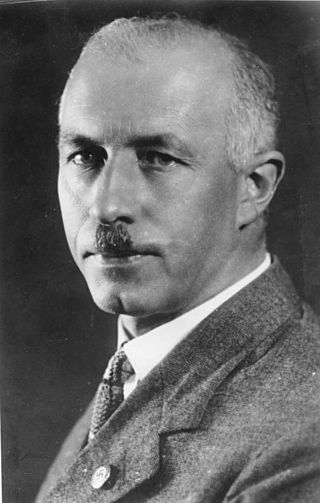
Gottfried Feder was a German civil engineer, a self-taught economist, and one of the early key members of the Nazi Party and its economic theoretician. It was one of his lectures, delivered in 1919, that drew Adolf Hitler into the party.
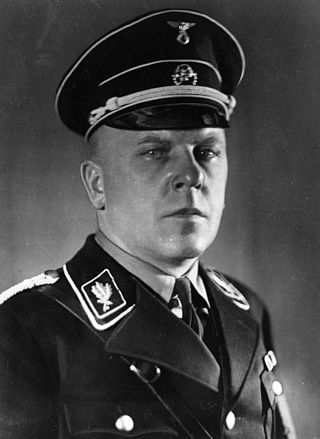
Max Amann was a high-ranking member of the Nazi Party, a German politician, businessman and art collector, including of looted art. He was the first business manager of the Nazi Party and later became the head of Eher Verlag, the official Nazi Party publishing house. He was also the Reichsleiter for the press. After the war ended, Amann was arrested by U.S. military occupation authorities. A denazification court deemed him a Hauptschuldiger. Amann was sentenced to ten years in a labour camp, stripped of his property, pension rights, and virtually all of his fortune.

Gregor Strasser was a German politician and early leader of the Nazi Party. Along with his younger brother Otto, he was a leading member of the party's left-wing faction, which brought them into conflict with the dominant faction led by Adolf Hitler, resulting in his murder in 1934. The brothers' strand of the Nazi ideology is known as Strasserism.
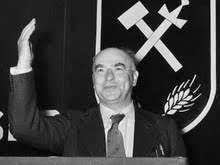
Otto Johann Maximilian Strasser was a German politician and an early member of the Nazi Party. Otto Strasser, together with his brother Gregor Strasser, was a leading member of the party's more radical wing, whose ideology became known as Strasserism, and broke from the party due to disputes with the dominant Hitlerite faction. He formed the Black Front, a group intended to split the Nazi Party and take it from the grasp of Hitler. During his exile and World War II, this group also functioned as a secret opposition group.

Strasserism is a strand of Nazism which adheres to revolutionary nationalism and economic antisemitism. It calls for a more radical, mass-action and worker-based movement than what was advocated by the leadership of the Nazi Party. Strasserism derived its name from Gregor and Otto Strasser, two brothers initially associated with this position. Otto Strasser originally led a faction within the Nazi Party, but was expelled from the party in 1930 and created the Black Front as a rival organization. He fled Germany in 1933 and returned after World War II. Strasserism allegedly had a considerable degree of support among the SA, which led to Strasserists being purged by Adolf Hitler during the Night of the Long Knives in 1934, with Gregor Strasser being murdered. In the 1980s, Strasserism again began to play an active role in politics after it found support among some leading members of the National Front party in the UK.

Hermann Esser was an early member of the Nazi Party (NSDAP). A journalist, Esser was the editor of the Nazi paper, Völkischer Beobachter, a Propaganda Leader, and a Vice President of the Reichstag. In the early days of the party, he was a de facto deputy of Adolf Hitler. As one of Hitler's earliest followers and friends, he held influential positions in the party during the Weimar Republic, but increasingly lost influence during the Nazi era.

Erich Koch was a Gauleiter of the Nazi Party (NSDAP) in East Prussia from 1 October 1928 until 1945. Between 1941 and 1945 he was Chief of Civil Administration of Bezirk Bialystok. During this period, he was also the Reichskommissar in Reichskommissariat Ukraine from September 1941 until August 1944 and in Reichskommissariat Ostland from September 1944. After the Second World War, Koch stood trial in Poland and was convicted in 1959 of war crimes and sentenced to death. The sentence was later commuted to life in prison and Koch died of natural causes in his cell at the Barczewo prison on 12 November 1986.
The Bamberg Conference included some sixty members of the leadership of the Nazi Party, and was specially convened by Adolf Hitler in Bamberg, in Upper Franconia, Germany on Sunday 14 February 1926 during the "wilderness years" of the party.
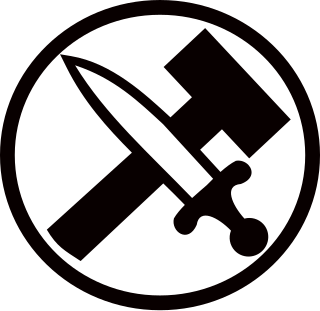
The Combat League of Revolutionary National Socialists, more commonly known as the Black Front, was a political group formed by Otto Strasser in 1930 after he resigned from the Nazi Party (NSDAP) to avoid being expelled.

Hans Nieland was a politician of the German Nazi-Party (NSDAP) and Lord Mayor of Dresden from 1940 until 1945.

Johann Heinrich "Hans" Hinkel was a journalist, Nazi Party official and politician in Nazi Germany. He mainly worked in the Reich Chamber of Culture and the Reich Ministry of Propaganda. He was involved in executing the policy of excluding Jews from German cultural life, and headed the Ministry's film division. He was also an SS-Gruppenführer, and was imprisoned in Poland for several years after the end of the Second World War.

Rudolf Jordan was the Gauleiter in Halle-Merseburg and Magdeburg-Anhalt in the time of the Third Reich. After the war, he was sentenced to 25 years in a Soviet Union labour camp. He was released from the camp in October 1955, and died in Munich in 1988.
Wilhelm Friedrich Loeper was a German Nazi politician. He served as the Gauleiter in the Gau of Magdeburg-Anhalt and was the Reichsstatthalter of the Free States of Anhalt and Brunswick
Franz Eher Nachfolger GmbH was the central publishing house of the Nazi Party and one of the largest book and periodical firms during the Nazi Germany. It was acquired by the party on 17 December 1920 for 115,000 Papiermark.

Der Angriff was the official newspaper of the Berlin Gau of the Nazi Party. Founded in 1927, the last edition of the newspaper was published on 24 April 1945.

Helmuth Brückner was Gauleiter of the National Socialist German Workers Party (NSDAP) in Silesia from 1925 until 1934, when he fell out of political favor.
Ernst Schlange was a German Nazi Party official and politician who served as Gauleiter of Gross-Berlin and later of Gau Brandenburg. He was also a lawyer and a member of the Prussian Landtag. Severely wounded in World War I, he became active in various anti-Semitic, far right political groups and eventually joined the National Socialist German Worker's Party. He was opposed to the Party's more extreme tactics for gaining power and was a close ally of the Strasser brothers. After their fall from power, Schlange lost his leadership posts by the mid-1930s. He died in Soviet captivity after the end of World War II.
Axel Herbert Ewald Ripke was a German journalist and politician of the German Fatherland Party and the Nazi Party (NSDAP). Among other things, he was one of the first Gauleiters of the NSDAP and an early mentor of Joseph Goebbels.
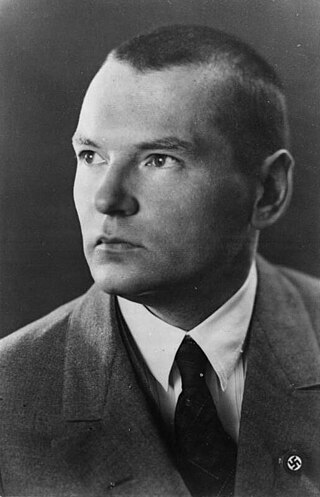
Ludolf Haase was a Nazi Party official who served as Gauleiter in Southern Hanover from 1925 to 1928.
The National Socialist Working Association, sometimes translated as the National Socialist Working Community was a short-lived group of about a dozen Nazi Party Gauleiter brought together under the leadership of Gregor Strasser in September 1925. Its full name was the Arbeitsgemeinschaft der nord- und westdeutschen Gaue der NSDAP. Aligned with the Strasserist wing of the Party, it unsuccessfully sought to steer the Party leadership in that direction by updating the Party program of 1920. Party Chairman Adolf Hitler perceived the Association as a threat to his leadership, so its activities were curtailed shortly after the Bamberg Conference of 14 February 1926 presided over by him, and it was formally dissolved on 1 October of that year.












